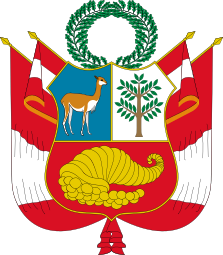Cornucopia
In classical antiquity, the cornucopia (/ˌkɔːrnjəˈkoʊpiə, ˌkɔːrnə-, ˌkɔːrnu-, ˌkɔːrnju-/), from Latin cornu (horn) and copia (abundance), also called the horn of plenty, was a symbol of abundance and nourishment, commonly a large horn-shaped container overflowing with produce, flowers, or nuts.
Baskets or panniers of this form were traditionally used in western Asia and Europe to hold and carry newly harvested food products. The horn-shaped basket would be worn on the back or slung around the torso, leaving the harvester's hands free for picking.
In Greek/Roman mythology
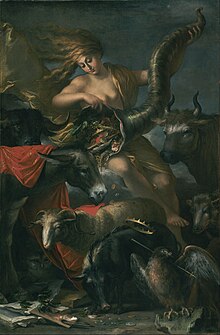

In another myth, the cornucopia was created when
The cornucopia became the attribute of several
Modern depictions
In modern depictions, the cornucopia is typically a hollow, horn-shaped wicker basket filled with various kinds of festive
Cornucopia motifs appear in some modern literature, such as Terry Pratchett's Wintersmith, and Suzanne Collins's The Hunger Games.
The horn of plenty is used for body art and at Thanksgiving, as it is a symbol of fertility, fortune and abundance.[4]
Gallery
-
Plouton with a cornucopia and Demeter with a sceptre and plough, by the Orestes Painter, 440-430 BC, ceramic, National Archaeological Museum, Athens, Greece
-
Roman statue of Fortuna, copy after a Greek original from the 4th century BC, marble, Vatican Museums, Rome
-
Ancient Greek oktadrachm of Ptolemy IV Philopator with a cornucopia, 221–204 BC, gold, Metropolitan Museum of Art, New York
-
Renaissance column capital in The Circumsicion of Jesus, by Andrea Mantegna, c.1461, tempera on wood, Uffizi, Florence, Italy
-
Renaissance relief of Ceres, on the east facade of the Lescot Wing in the Cour Carrée, Louvre Palace, by Jean Goujon, 1553
-
Renaissance cornucopia on the Maison des Cariatides, Dijon, France, unknown architect or sculptor, c.1550-1600[5]
-
Portrait of William III of Orange, aged 10, portrait by Jan Vermeer van Utrecht and decor by Jan Davidsz. de Heem, c.1659-1666, oil on canvas, Museum of Fine Arts of Lyon, France
-
Baroque cornucopia in the ceiling of the Galerie d'Apollon, Louvre Palace, Paris, by Louis Le Vau and Charles Le Brun, after 1661[6]
-
Baroque pair of cornucopias on the garden façade of theVersailles, France, by Jules Hardouin-Mansart, 1678–1688[7]
-
L’Abondance, byVersailles, France
-
, US
-
Rococo personification ofChelsea Porcelain Factory, c.1760-1770, porcelain, Indianapolis Museum of Art, Indianapolis, US
-
Louis XVI style armchair with a pair of cornucopia, by Georges Jacob, 1765, gilt wood with cushions, Cabinet Doré de la Reine, Palace of Versailles
-
Peace bringing back Prosperity, by Élisabeth Vigée Le Brun, 1780, oil on canvas, Louvre
-
Rococo pair of cornucopia in the Opéra national de Lorraine, Nancy, France, designed by Jean-François de La Borde, 1753[8]
-
Louis XVI style cornucopia on an ewer, by François Antoine Pfeiffer, Gilbert Drouet and the Sèvres Porcelain Factory, 1795, hard-paste porcelain, Metropolitan Museum of Art
-
Neoclassical cornucopias on the pedestal of a clock, by Antoine André Ravrio, 19th century, marble and gilt bronze, Petit Palace, Paris
-
Neoclassical cornucopia on a vase, by the Sèvres Porcelain Factory, 1814, hard-paste porcelain with platinum background and gilt bronze mounts, Louvre[9]
-
Neoclassical cornucopia on the Choir Carpet of Notre-Dame de Paris, by the Gobelins Manufactory, 1825-1833[10]
-
TwoBeaux Arts mascarons of Avenue Henri-Martin no. 87, Paris, designed by Albert Walwein, 1892
-
Beaux Arts cornucopia on the Traian Hall (Calea Călărașilor no. 133), Bucharest, by Giulio Magno, 1896
-
Beaux Arts conrnucopia of Strada Termopile no. 2, Bucharest, unknown architect, c.1900
-
Beaux Arts stuccos with pairs of cornucopia in the Generala Building (Bulevardul Regina Elisabeta no. 5), Bucharest, Romania, by Oscar Maugsch, 1906-1908[12]
-
Art Deco dressing table and chair set decorated with cornucopias, by Paul Follot, 1919, marble and wood encrusted, lacquered and gilded, Musée d'Art Moderne de Paris
-
Art Deco cornucopias on the pediment corners of the Mihai Zisman House (Calea Călărașilor no. 44), Bucharest, by architect Soru, 1920
-
Art Deco cornucopias ofAvenue des Champs-Élyséesno. 77, Paris, unknown architect, c.1930
-
Stalinist cornucopias on the administration building of the "Kryvbasshahtoprohidka" and "Pivdenruda" associations, Kryvyi Rih, Ukraine, unknown architect, 1950s
-
Modernist relief of Europe, forcing the wild bull on its knees and pouring out the cornucopia with the blessings of prosperity, in the Saarlouis Town Hall, Germany, by Nikolaus Simon, 1953-1955
See also
- Akshaya Patra
- Chalice of Doña Urraca
- Cup of Jamshid
- Drinking horn
- Holy Chalice
- Holy Grail
- List of mythological objects
- Nanteos Cup
- Relic
- Sampo
- Venus of Laussel
- Śarīra
- Cintamani
- Mani stone
- Ashtamangala
- Yasakani no Magatama
- Kaustubha Gem
- Luminous gemstones
- Philosopher's stone
- Sendai Daikannon statue
- Syamantaka Gem
- Eight Treasures
- Cornucopian
Notes
- ^ David Leeming, The Oxford Companion to World Mythology (Oxford University Press, 2005), p. 13; Robert Parker, Polytheism and Society at Athens (Oxford University Press, 2005), p. 422.
- ^ Ovid, Metamorphoses 9.87–88, as cited by J. Rufus Fears, "The Cult of Virtues and Roman Imperial Ideology," Aufstieg und Niedergang der römischen Welt II.17.2 (1981), p. 821.
- ^ Clinton, Kevin (1992). Myth and Cult: The Iconography of the Eleusinian Mysteries. Stockholm. pp. 105–107.
{{cite book}}: CS1 maint: location missing publisher (link) - ^ Hastings, James, ed. (1910). Encyclopaedia of Religion and Ethics. Vol. III.[page needed]
- ^ "Maison dite des Cariatides ou Maison Pouffier" [House known as the Caryatids or Maison Pouffier]. pop.culture.gouv.fr (in French). Retrieved 18 September 2023.
- ISBN 978-0-500-02544-4.
- ^ Martin, Henry (1927). Le Style Louis XIV (in French). Flammarion. p. 21.
- ^ "Opéra - théâtre". pop.culture.gouv.fr (in French). Retrieved 18 September 2023.
- ^ "Paire de Vases « Fuseau »". amisdulouvre.fr (in French). Retrieved 10 May 2023.
- ^ "tapis de choeur Louis-Philippe". pop.culture.gouv.fr (in French). Retrieved 18 September 2023.
- ^ Jones 2014, p. 294.
- ISBN 978-973-0-22923-3.
References
- Jones, Denna, ed. (2014). Architecture The Whole Story. Thames & Hudson. ISBN 978-0-500-29148-1.
External links
 Media related to Cornucopia at Wikimedia Commons
Media related to Cornucopia at Wikimedia Commons





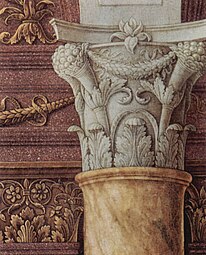

![Renaissance cornucopia on the Maison des Cariatides, Dijon, France, unknown architect or sculptor, c.1550-1600[5]](http://upload.wikimedia.org/wikipedia/commons/thumb/8/8e/Dijon_%2821%29_Maison_des_Cariatides_-_15.jpg/170px-Dijon_%2821%29_Maison_des_Cariatides_-_15.jpg)

![Baroque cornucopia in the ceiling of the Galerie d'Apollon, Louvre Palace, Paris, by Louis Le Vau and Charles Le Brun, after 1661[6]](http://upload.wikimedia.org/wikipedia/commons/thumb/e/e8/Le_Verseau_dans_la_galerie_d%27Apollon.jpg/340px-Le_Verseau_dans_la_galerie_d%27Apollon.jpg)
![Baroque pair of cornucopias on the garden façade of the Palace of Versailles, Versailles, France, by Jules Hardouin-Mansart, 1678–1688[7]](http://upload.wikimedia.org/wikipedia/commons/thumb/9/9b/2017_Escultura._Palacio_de_Versalles_P41.jpg/170px-2017_Escultura._Palacio_de_Versalles_P41.jpg)
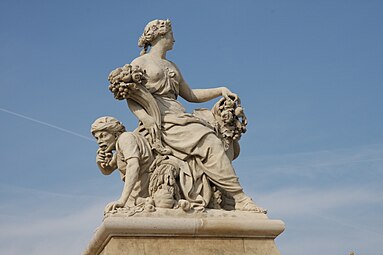




![Rococo pair of cornucopia in the Opéra national de Lorraine, Nancy, France, designed by Jean-François de La Borde, 1753[8]](http://upload.wikimedia.org/wikipedia/commons/thumb/d/d6/Nancy_op%C3%A9ra_national_de_Lorraine_armoiries_de_Nancy.jpg/383px-Nancy_op%C3%A9ra_national_de_Lorraine_armoiries_de_Nancy.jpg)

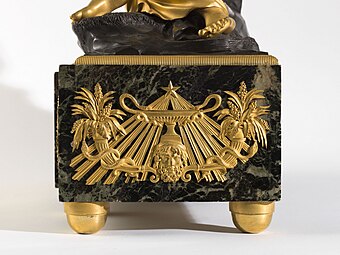
![Neoclassical cornucopia on a vase, by the Sèvres Porcelain Factory, 1814, hard-paste porcelain with platinum background and gilt bronze mounts, Louvre[9]](http://upload.wikimedia.org/wikipedia/commons/thumb/5/5e/Pair_of_Spindle_Vases_-_OA_11090_-_Louvre_%2805%29.jpg/155px-Pair_of_Spindle_Vases_-_OA_11090_-_Louvre_%2805%29.jpg)
![Neoclassical cornucopia on the Choir Carpet of Notre-Dame de Paris, by the Gobelins Manufactory, 1825-1833[10]](http://upload.wikimedia.org/wikipedia/commons/thumb/3/38/Paris_-_Cath%C3%A9drale_Notre-Dame_de_Paris_-_Tapis_monumental_du_ch%C5%93ur_-_D%C3%A9tail_-6.JPG/340px-Paris_-_Cath%C3%A9drale_Notre-Dame_de_Paris_-_Tapis_monumental_du_ch%C5%93ur_-_D%C3%A9tail_-6.JPG)
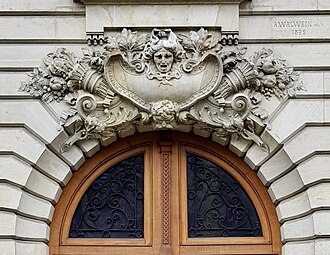


![Beaux Arts cornucopias on the Petit Palais, Paris, by Charles Giraud, 1900[11]](http://upload.wikimedia.org/wikipedia/commons/thumb/8/85/Paris_-_Fa%C3%A7ade_du_Petit_Palais_-_PA00088878_-_035.jpg/383px-Paris_-_Fa%C3%A7ade_du_Petit_Palais_-_PA00088878_-_035.jpg)
![Beaux Arts stuccos with pairs of cornucopia in the Generala Building (Bulevardul Regina Elisabeta no. 5), Bucharest, Romania, by Oscar Maugsch, 1906-1908[12]](http://upload.wikimedia.org/wikipedia/commons/thumb/1/1c/Interior_of_the_BCR_Headquarters_Building_31.jpg/122px-Interior_of_the_BCR_Headquarters_Building_31.jpg)






